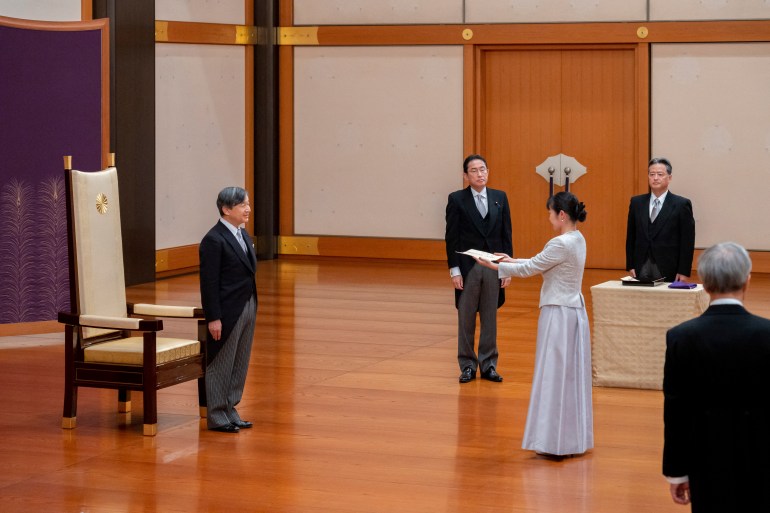One of the notable additions to the cabinet is Yoko Kamikawa, who became Japan’s first female Minister of Foreign Affairs in nearly two decades.
“We would like to demonstrate Japan’s presence and build trust with our counterparts around the world,” she said on Thursday at her first press conference since taking office. She also said Japan would seek “responsible actions from China” and maintain conversations with its neighbour in an effort to improve their strained ties.
The 70-year-old was previously Japan’s justice minister and oversaw the execution of significant figures within the Aum Shinrikyo doomsday cult, which was responsible for the fatal sarin gas attack on the Tokyo metro system in 1995.
Wednesday’s reshuffle comes as support for Kishida’s party continues to decline. According to an August Kyodo News poll, only 33.6 percent of Japanese citizens currently support the prime minister. Approval ratings have been falling since July 2022 and reached a low of 33.1 percent last December.
Kishida is hoping that the appointment of more women will boost his support among more progressive and younger voters.
Before Wednesday’s announcement, only two out of 19 cabinet members were female. Japan’s representation of women in politics is notably sparse in comparison with other countries, ranking 138 out of 146 nations for gender equality in politics, according to the World Economic Forum.
“[It is] a small step in the right direction from a political party with a very poor record of female representation,” Jeffrey Hall, a special lecturer in Japanese Studies at Kanda University of International Studies, told Al Jazeera.
Among the female appointees, Hanako Jimi, a former medical doctor, is now the Minister for Regional Revitalisation. Ayuko Kato, the youngest cabinet member at 44 years old, will be in charge of child policies. She was previously a management consultant and is the daughter of a renowned politician. The reconstruction minister is now Shinako Tsuchiya, who was previously a culinary researcher and flower artist.
Yuko Obuchi, who was appointed to chair the ruling Liberal Democratic Party’s (LDP) election strategy committee, also hails from a political dynasty. She is the daughter of late Prime Minister Keizo Obuchi, who was himself the son of a member of parliament.
A one-time industry minister, Obuchi was forced to resign in 2014 over a scandal over political funds but has won back Kishida’s trust.

He says he wants her to uncover her talent and help move the party towards its goal of having women take 30 percent of its parliamentary seats within 10 years.
Hall noted that while appointing five women in top government positions was significant, it would not address the LDP’s wider problem of nominating and supporting male candidates over women.
At the moment, the ruling party does not set quotas for female candidates, unlike rival parties such as the Japan Communist Party. As a result, the LDP gives preferential treatment to incumbents, a majority of whom are male.
“As long as the institutional changes to actually increase the overall number of women within the party aren’t implemented, it is largely style over substance here,” said Hall.
Economic woes
More immediately, analysts doubt female representation alone will be enough to boost support for Kishida’s government over the longer term. New and significant policy changes are needed, they say.
“Persistent issues such as inflation, the rising cost of living and the Fukushima wastewater release have exacerbated Kishida’s declining popularity,” Hajime Kidera, a politics professor at Meiji University, told Al Jazeera.
Although Kishida’s approval ratings went up slightly in May after the G7 summit – held in the premier’s hometown Hiroshima – they have dropped again since, Kidera pointed out.
Much of this recent decline has to do with Kishida’s mishandling of Japan’s My Number Identification system.
First introduced in 2015 as a means of creating a single national identifying number for all citizens, Japan has struggled to get the entire Japanese population behind it. The system has also been plagued with technical issues and significant data privacy concerns, as about 130,000 cards were linked to the bank accounts of other people.
But Kishida has also been struggling with the continuing fallout from the assassination of former Prime Minister Shinzo Abe.
Investigations into the killing exposed deep-seated ties between some politicians from the ruling LDP and the Unification Church, a fringe religious group that some have labelled a cult. The church is known to solicit funds by coercion, threats or linking donations to spiritual salvation, and Abe’s killer was reportedly motivated by the former prime minister’s alleged close association with the church.
In the aftermath of Abe’s death, three cabinet members – Economic Revitalisation Minister Daishiro Yamagiwa, Justice Minister Yasuhiro Hanashi, and Internal Affairs Minister Minoru Terada – tendered their resignations between October and November 2022.
But Kishida’s handling of their departures was met with widespread criticism, with voters saying he took too long to act. Not long afterwards, his support hit rock bottom.
After this week’s reshuffle, Kishida announced his government would focus on efforts to tackle inflation and the rising cost of living.
The country’s inflation rate jumped to a 41-year high in January, as wages continued to sink. According to data from the Cabinet Office, Japan’s economy grew 4.8 percent in this second quarter, less than the initial estimate of 6 percent.
Whether the new policies – expected by next month – or the reshuffle do much to lift Kishida’s persistently low ratings might not matter much in the end.
Neither right-wing like his predecessor Abe nor liberal like Taro Kono, a former rival during the 2021 party leadership elections, Kishida represents a compromise within his party.
“There really isn’t any other person in the party that can actually step up and challenge him and get the support of enough conservatives and enough moderates,” Hall said.
